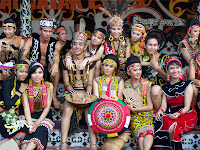Dayak People
 |
| DAYAK PEOPLE IN BORNEO |
Dayak
People is indigenous people to Borneo. It loose term for over 200
rivene and hill-dwelling ethnic subgroups,located principally in
interior of Borneo, each with its own dialect,customs.territory and
culture,although common distinguishing traits are readily identifiable.
Dayak languages are categorized as part of the Austronesian languages in Asia. Dayak population range from 2 to 4 million. Dayak people have some history, ethnics, agriculture,and religion.
The consensus interpretation in modern anthropology is that nearly all indigenous peoples
of South East Asia, including the Dayaks, are descendants of a larger
Austronesian migration from Asia, thought to have settled in the South
East Asian Archipelago some 3,000 years ago. The first populations spoke
closely-related Austronesian languages, from which Dayak languages are traced. About 2,450 years ago, metallurgy was introduced; it later became widespread.
The Dayak people of Borneo possess an indigenous account of their
history, partly in writing and partly in common cultural customary
practices. In addition, colonial accounts and reports of Dayak activity
in Borneo detail carefully cultivated economic and political
relationships with other communities as well as an ample body of
research and study considering historical Dayak migrations. In
particular, the Iban or the Sea Dayak exploits in the South China Seas
are documented, owing to their ferocity and aggressive culture of war
against sea dwelling groups and emerging Western trade interests in the
19th and 20th centuries.
The main ethnic groups of Dayaks are the Bakumpai and Dayak Bukit of South Kalimantan, The Ngajus, Baritos, Benuaqs of East Kalimantan, the Kayan and Kenyah groups and their subtribes in Central Borneo and the Ibans, Embaloh (Maloh), Kayan, Kenyah, Penan, Kelabit, Lun Bawang and Taman populations in the Kapuas and Sarawak regions. Other populations include the Ahe, Jagoi, Selakau, Bidayuh, and Kutais.
Traditionally, Dayak agriculture was based on swidden
rice cultivation. Agricultural Land in this sense was used and defined
primarily in terms of hill rice farming, ladang (garden), and hutan
(forest). Dayaks organised their labour in terms of traditionally based
land holding groups which determined who owned rights to land and how it
was to be used. The "green revolution" in the 1950s, spurred on the
planting of new varieties of wetland rice amongst Dayak tribes.
The Dayak indigenous religion has been given the name Kaharingan, and may be said to be a form of animism. For official purposes, it is categorized as a form of Hinduism
in Indonesia. Nevertheless, these generalizations fail to convey the
distinctiveness, meaningfulness, richness and depth of Dayak religion,
myth and teachings. Underlying the world-view is an account of the
creation and re-creation of this middle-earth where the Dayak dwell,
arising out of a cosmic battle in the beginning of time between a primal
couple, a male and female bird/dragon (serpent). Representations of
this primal couple are amongst the most pervasivel motifs of Dayak art. ,
some Dayaks converted to Islam,
abandoning certain cultural rites and practices. Christianity was
introduced by European missionaries in Borneo. Religious differences
between Muslim and Christian natives of Borneo has led, at various
times, to communal tensions. Relations, however between all religious
groups are generally good.Muslim Dayaks have however retained their
original identity and kept various customary practices consistent with
their religion.
Tidak ada komentar:
Posting Komentar